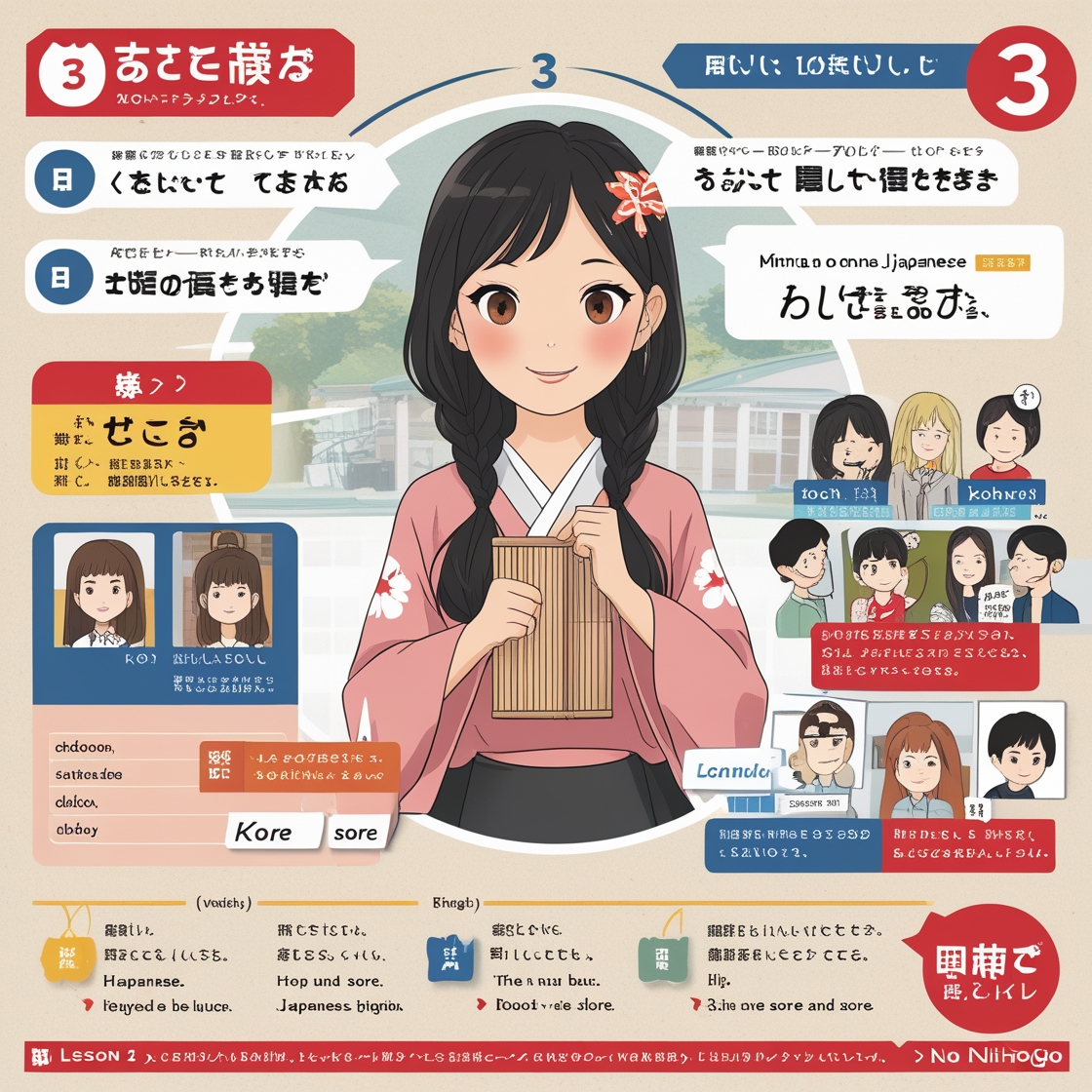Minna no Nihongo Lesson 3 Vocabulary: If you’re learning Japanese, Minna no Nihongo is one of the most popular textbooks used to guide beginners through the language. Lesson 3 of Minna no Nihongo introduces a range of essential vocabulary that forms the foundation of everyday conversations.
This article will explain the key vocabulary from Lesson 3, along with their meanings and examples to help you master them effectively. Whether you’re a beginner or reviewing your Japanese skills, understanding these words will significantly improve your fluency.
Read More: Minna No Nihongo Lesson 5 Listening.
Minna no Nihongo Lesson 3 Vocabulary
1. あの (ano) – That (over there)
- Meaning: Used to refer to something or someone that is far from both the speaker and the listener.
- Example: あの人は先生です。(Ano hito wa sensei desu.)
That person is a teacher.
2. これ (kore) – This (thing)
- Meaning: Refers to something close to the speaker.
- Example: これはペンです。(Kore wa pen desu.)
This is a pen.
3. それ (sore) – That (thing)
- Meaning: Refers to something close to the listener, or previously mentioned.
- Example: それは何ですか。(Sore wa nan desu ka?)
What is that?
4. どれ (dore) – Which (thing)?
- Meaning: Used when asking about a choice between three or more things.
- Example: どれが好きですか。(Dore ga suki desu ka?)
Which one do you like?
5. ここ (koko) – Here
- Meaning: Refers to a location close to the speaker.
- Example: ここは学校です。(Koko wa gakkou desu.)
This is a school.
6. そこ (soko) – There
- Meaning: Refers to a location near the listener.
- Example: そこは図書館です。(Soko wa toshokan desu.)
That is the library.
7. あそこ (asoko) – Over there
- Meaning: Refers to a place far from both the speaker and the listener.
- Example: あそこにレストランがあります。(Asoko ni resutoran ga arimasu.)
There is a restaurant over there.
8. どこ (doko) – Where?
- Meaning: Used to ask about the location of something or someone.
- Example: トイレはどこですか。(Toire wa doko desu ka?)
Where is the bathroom?
9. かばん (kaban) – Bag
- Meaning: A bag, typically used for carrying items.
- Example: かばんはどこですか。(Kaban wa doko desu ka?)
Where is the bag?
10. ほん (hon) – Book
- Meaning: Refers to a book.
- Example: これは日本語の本です。(Kore wa nihongo no hon desu.)
This is a Japanese book.
11. これから (kore kara) – From now on
- Meaning: Refers to something happening from the present onward.
- Example: これから勉強します。(Kore kara benkyou shimasu.)
I will study from now on.
12. いえ (ie) – House
- Meaning: Refers to a house or home.
- Example: いえに帰ります。(Ie ni kaerimasu.)
I am going home.
13. うけつけ (uketsuke) – Reception (desk)
- Meaning: The desk or area where one receives information or assistance.
- Example: うけつけはあそこです。(Uketsuke wa asoko desu.)
The reception desk is over there.
14. おてあらい (otearai) – Restroom
- Meaning: Another term for the bathroom or toilet.
- Example: おてあらいはどこですか。(Otearai wa doko desu ka?)
Where is the restroom?
15. えんぴつ (enpitsu) – Pencil
- Meaning: A tool used for writing or drawing.
- Example: えんぴつを貸してください。(Enpitsu o kashite kudasai.)
Please lend me a pencil.

How to Use These Words in Everyday Conversations
Understanding the vocabulary from Minna no Nihongo Lesson 3 will help you navigate a variety of everyday situations. For example:
- Asking for Directions:
If you’re lost, you can ask questions like, “トイレはどこですか?” (Toire wa doko desu ka?) meaning “Where is the bathroom?” or “あそこにレストランがありますか?” (Asoko ni resutoran ga arimasu ka?) meaning “Is there a restaurant over there?” - Talking About Objects Around You:
If you’re talking about things around you, you can use words like “これ” (kore) for this, “それ” (sore) for that, and “あの” (ano) for that over there. For example, “これはペンです” (Kore wa pen desu) means “This is a pen.” - Talking About Places:
Use location words like “ここ” (koko) for here, “そこ” (soko) for there, and “あそこ” (asoko) for over there. For example, “ここは学校です” (Koko wa gakkou desu) meaning”This is a school.”
Minna no Nihongo lesson 3 vocabulary answers
In the Minna no Nihongo textbook, the exercises will usually ask you to choose the correct vocabulary or complete sentences using the words learned. Here are some example answers you might encounter:
Exercise Example 1: Matching the Vocabulary with its Meaning
- これ (kore): This (thing)
- それ (sore): That (thing)
- あれ (are): That (thing) over there
- どれ (dore): Which (thing)?
- ここ (koko): Here (place)
- そこ (soko): There (place)
- あそこ (asoko): Over there (place)
- どこ (doko): Where?
Exercise Example 2: Filling in the blanks
- これは____です。 (This is a pen.)
Answer: ペン (pen) - あの____は先生です。 (That person is a teacher.)
Answer: 人 (hito – person) - えんぴつは____ですか? (Where is the pencil?)
Answer: どこ (doko – where) - これは____ですか? (What is this?)
Answer: 何 (nani – what)
Exercise Example 3: Sentence formation
- これは本です。(Kore wa hon desu.) – This is a book.
- それはかばんです。(Sore wa kaban desu.) – That is a bag.
- あれは日本語の本です。(Are wa nihongo no hon desu.) – That over there is a Japanese book.
- どれが一番好きですか?(Dore ga ichiban suki desu ka?) – Which one do you like the most?
Conclusion
Mastering the vocabulary in Minna no Nihongo Lesson 3 is essential to your Japanese learning journey. Whether using these words to ask for directions, talk about objects, or describe locations, understanding the meanings and proper usage will help you speak more naturally in everyday situations.
Practice these words, and you’ll gain confidence in communicating in Japanese. Keep studying, and don’t forget to revisit these words to reinforce your understanding!